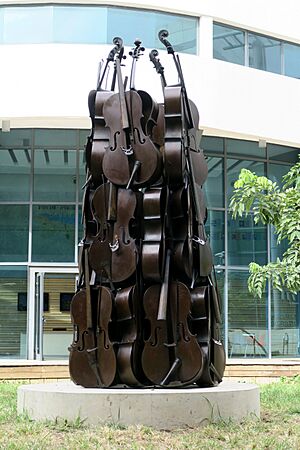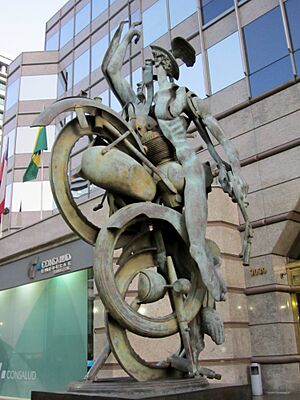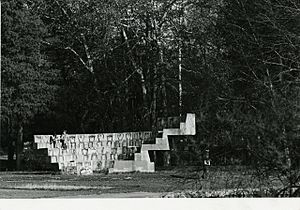Arman facts for kids
Quick facts for kids
Arman
|
|
|---|---|

Arman in 1969
|
|
| Born |
Armand Pierre Fernandez
November 17, 1928 |
| Died | October 22, 2005 (aged 76) New York City, US
|
| Nationality | French, naturalized American (1973) |
| Known for | Sculpture, painting, printmaking |
| Movement | Nouveau Réalisme, ZERO |
Arman (born November 17, 1928 – died October 22, 2005) was a famous artist. He was born in Nice, France, with the name Armand Fernandez. Arman started as a painter. He later used everyday objects in his art.
He is most famous for his "Accumulations." These were collections of many similar items. He also created art by breaking objects and putting them back together.
Contents
Arman's Early Life and Learning
Arman's father, Antonio Fernandez, was an antiques dealer. He was also an artist, photographer, and musician. Arman learned about oil painting and photography from his father.
In 1946, Arman finished high school. He then studied art at a special school in Nice. He also learned judo and met two other artists, Yves Klein and Claude Pascal. They became good friends.
After his studies, Arman went to the École du Louvre in Paris. There, he learned about old art and art from Asia. He also taught judo for a while.
How Arman Started His Art Career
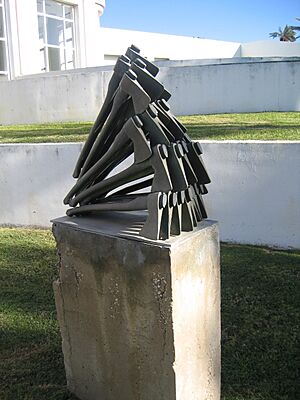
From early on, Arman liked to collect many similar objects. He used these collections in his art. At first, he focused on his abstract paintings. He thought they were more important.
But in 1959, people really liked his first "Accumulation." This made him see how powerful this type of art could be. Later, in 1962, he started welding metal objects together. He made "Accumulations" of things like axes.
New Ideas and a Name Change
In 1954, Arman saw an art show by Kurt Schwitters. This inspired him to create his "Cachets." These were artworks made by using rubber stamps on paper and fabric. They were a big success.
Arman used to sign his art with only his first name, "Armand." This was like Van Gogh, who signed his art "Vincent." In 1957, Arman changed his name to "Arman." When he became an American citizen in 1973, his full name became Armand Pierre Arman. But he still used "Arman" as his artist name.
How Arman's Art Changed
From 1959 to 1962, Arman developed his most famous styles. These were "Accumulations" and "Poubelles." "Poubelles" is French for "trash bins."
- Accumulations: These were collections of everyday items. He put them inside clear plastic boxes or resin. His first welded "Accumulations" were made in 1962.
- Poubelles: These were collections of actual trash. In 1960, he filled an art gallery in Paris with trash. He called this artwork Le Plein (The Full). It was a response to his friend Yves Klein's earlier show, Le Vide (The Void), which was an empty gallery.
In 1960, Arman helped start a group called Nouveau Réalisme. This group included other young artists like Yves Klein and Jean Tinguely. They wanted to show new ways of looking at reality. They used everyday objects to make art. Arman also worked with the ZERO art movement in Germany.
In 1961, Arman showed his art in the United States for the first time. He also started making art by destroying things. He called these "Coupes" (Cuts) and "Colères" (Angers). He would slice, burn, or smash objects. He often used musical instruments like violins or saxophones.
Arman and Andy Warhol
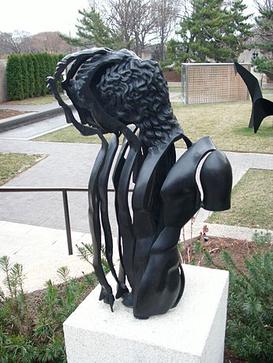
Arman appeared in a film by Andy Warhol called Dinner at Daley's. This film showed a dinner event by artist Daniel Spoerri. Andy Warhol even owned two of Arman's "Poubelles."
Moving to New York City
Arman loved New York City. He started living there part-time in 1961. He met famous artist Marcel Duchamp there. Arman began creating large public sculptures in New York.
He made many different "Accumulations." These included tools, watches, car parts, and musical instruments. Musical instruments became a big part of his art.
One of his biggest "Accumulations" is Long Term Parking. It is in France. This sculpture is 60 feet tall. It has 60 cars set in concrete. Another huge work is Hope for Peace (1995). It was made for the government of Lebanon. This 32-meter tall monument has 83 tanks and military vehicles.
Arman's Family Life
In 1953, Arman married Eliane Radigue. They had two daughters, Marion and Anne, and a son, Yves. In 1971, he married Corice Canton. They had a daughter, Yasmine, and a son, Philippe. He later had another son, Yves Cesar.
Arman passed away in New York in 2005. Some of his ashes were buried in Paris in 2008.
Selected Exhibitions and Awards
Arman's art was shown in many places around the world. Here are a few examples:
- 1964: His art was shown at the Stedelijk Museum in Amsterdam.
- 1969: A traveling show called Arman: Accummulations Renault went to many cities.
- 1975: Arman: Objets Armés was shown in Paris.
- 1982: A big show called Arman: Parade der Objekte traveled to Germany and Israel.
- 1991: Arman: A Retrospective was shown at The Brooklyn Museum in New York.
- 2003: He was named "Sport Artist of the Year" in the United States.
- 2010-2011: A large show of his work was held at the Centre Georges Pompidou in Paris.
Where to See Arman's Art in the United States
You can find Arman's artworks in many public art collections. Here are some of them:
- Fine Arts Museums of San Francisco, California
- Hirshhorn Museum and Sculpture Garden, Washington, DC
- Ulrich Museum of Art, Wichita, Kansas
- The Museum of Modern Art, New York
- Boca Raton Museum of Art, Florida
Images for kids
See also
 In Spanish: Arman para niños
In Spanish: Arman para niños


